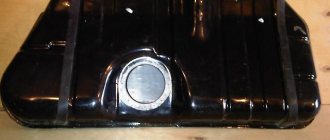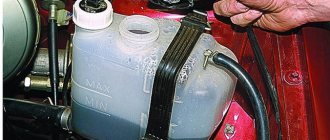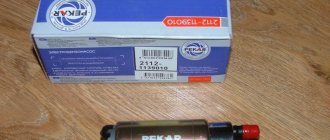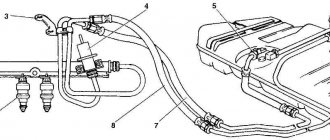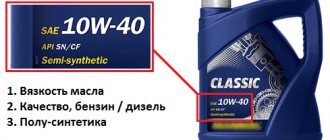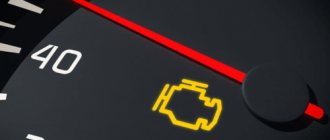The volume of the fuel tank in the car primarily determines the number of kilometers that can be driven without refueling. You need to know this if you are going on a long trip or spend a lot of time moving around the city. A car enthusiast needs to be able to plan his route in such a way as to be able to visit a gas station in a timely manner. Let's tell you what the volume of the tank is in a VAZ-2115 car.
VAZ 2114 tank volume: finding out the real numbers
Before we look at the main question - how much volume the VAZ 2114 tank holds, let’s look at the main technical characteristics of this car.
Technical characteristics of the VAZ 2114
Its engine parameters are as follows:
- working volume - 1499 cm3;
- total power - 77 hp;
- maximum rotation speed - 5200 min-1;
- maximum torque - 116 N/m.
In turn, the main operating parameters of the VAZ 2114 car look like:
- acceleration time from 0 to 100 km/h - 14 s;
- maximum possible speed - 157 km/h;
- fuel consumption in urban conditions (per 100 km) - 9.9 l;
- fuel consumption on a suburban highway (per 100 km) - 6.2 l;
- fuel consumption when traveling in mixed conditions (per 100 km) - 7.5 liters.
Now consider the main weight and dimensions of the car:
- total length - 4122 mm;
- full width - 1650 mm;
- height - 1422 mm;
- ground clearance - 165 mm;
- wheelbase size - 2460 mm;
- front track - 1400 mm;
- rear track - 1370 mm;
- weight (curb) - 985 kg;
- weight (total) - 1410 kg;
- fuel tank volume (full) - 43 l.
As you can see from the table above, the gas tank on the VAZ 2114 holds exactly 43 liters. Is this really so? Let’s look at it below.
Actual tank volume on the 14th model
As mentioned, the manufacturer claims that the volume of the 2114 tank is 43 liters (in some cases you can find a figure of 42.5 liters). And this figure is indeed very close to reality.
At the same time, it is worth considering a number of facts that can significantly affect capacity:
- Errors in the manufacture of the tank.
- Time of year and temperature.
- Fuel system volume.
The first of these factors is usually insignificant. But, as practice shows, sometimes the difference in the volumes of two identical tanks can reach (as a result of low production accuracy) 2 liters. Thus, on some machines the total volume can reach 45 liters (which is extremely rare).
This should also include the difference in weather conditions. In cold weather, the fuel contracts, and in warm weather, it expands. This factor also affects how many liters the tank on a VAZ 2114 can hold (if we take into account the full volume of gasoline that can fit in hot summers and winter frosts, the difference can reach 1.5 liters).
What to do if water gets into the tank
The volume of gasoline poured may become smaller if liquid accumulates in the tank. The parameters of the container will not change, but the composition of its contents will be different. When water gets into the tank, you can observe the following:
- difficulty starting the car in the morning;
- uneven engine operation;
- the need to warm up the car longer before starting.
Water enters the tank for various reasons. You can remove it in one of the following ways:
- Mix pure alcohol (from 200 to 500 milliliters) with gasoline, then pour these liquids into a container for fuel.
- Through the spool on the fuel rail. This is a more complicated method, since you will need to drain the liquid using a hose into any transparent container. To do this, apply voltage to the fuel pump using the diagnostic block.
- Drain manually using a long, thin hose from a drip line. You will need to place a bucket or any container under the liquid in the inspection hole or simply below the tank level.
You can prevent water from entering the gas tank by maintaining a constant fuel level in it (it is advisable to refuel “to capacity”). If you need to add gasoline
On a rainy or foggy day, fill the fuel container 100%. This simple technique will allow you to displace moist air from the system, which settles as condensation during movement. In late autumn, pour pure alcohol into the system (200 milliliters is enough) to remove accumulated water and prevent it from freezing.
There is a special offer on our website. You can get a free consultation with our corporate lawyer by simply submitting your question in the form below.
VAZ 2115 | Technical fluids and filling volumes
Technical fluids and filling volumes
| VAZ 2107: replacing the fuel sensor yourself Liquid name | Engine | Filling volume, l | Purpose and brand of recommended liquid | Maintenance interval |
| 1.2S | 3,2 | API SL (ILSAC GF-III) | ||
| Engine oil | 1.4S/1.4D/1.5S | 3,75 | SAE10W-30 Low temperature areas: SAE 5W-30 | |
| Liquid volume | 1.2S | 5,2 | Ethylene glycol coolant | |
| in the cooling system | 1.4S/1.4D/1.5S | 7,0 | ||
| Automatic transmission fluid | 1.4D/1.5S | 5,9±0.2 | ESSOJWS3309 or ISU DEXRON III | According to the vehicle maintenance regulations |
| Gear oil for manual transmission | 1.2S | 2,1 | SAE75W-85 | (see service book) |
| 1.4S/1.4D/1.5S | 1,8 | SAE 80W at low temperatures SAE 75W | ||
| Brake fluid | 0,5 | DOT 3 or DOT 4 | ||
| Power steering fluid | 1,1 | DEXRON II-D or DEXRON III |
* To ensure optimal performance of your vehicle, always use only the recommended automatic transmission fluid.
VAZ 2115 configurations
Self-replacement of the VAZ 2115 speed sensor
This popular descendant of the VAZ 21099, a prominent representative of the Samara-2 family, is a compact B class sedan.
Produced from 1997 to 2012 in three main trim levels:
- “Standard” VAZ 21150-20-ST;
- “Norma” VAZ 21150-21-NR;
- "Lux" VAZ 21150-22-LX.
The 20-ST package did not include any additional elements or options other than standard seat belts and electric door locks. The interior is without any special decorative details, with tweed seat upholstery and solid fabric inserts on the side panels.
With the advent of the “21–NR” (standard) configuration, the car was equipped with fog lights, seat belt warning lights and heated front seats. The electrical equipment was supplemented with front door window lifts.
The most equipped car was the Luxury class car (22-LX). In addition to everything that was in previous trim levels, buyers now have a choice of interior trims. The seat upholstery was made not only of tweed material, but also of velvet.
The level of car safety has increased thanks to the built-in ABS (anti-lock braking system). Installing power steering made the car easy to control and maneuverable.
In addition there were:
- rear side window lifts;
- heated rear seats;
- headlight cleaners;
- factory tinted windows.
Fuel tank VAZ-2115
The speedometer on the VAZ-2115 does not work: signs, reasons, replacing the sensor
Home Auto catalogs VAZ VAZ-2115 Fuel tank
- Sorting:
- default
- by article number
- by name
- List:
- hide products
# Part number Name Qty per model 2108-1101007 Fuel tank Qty per model: 1 10516470 Spring washer 6 Qty per model: 1 21083-3827010 Sensor Qty per model: 1 2108-3827010 Gasoline level indicator sensor Qty per model: 1 2108-3827010-02 Sensor Qty per model: 1 2108-1101080-10 Hose Qty per model: 1 21082-1101114 Tank clamp Qty per model: 1 2108-1101114 Tank clamp Quantity per model: 1 2108-1103010-10 Tank cap Quantity per model: 1
| Axle bearing LADA 2101-07 TRIALLI Article: CS 768 Order code: IM113912562 Manufacturer: TRIALLI |
| Fuel tank cap VAZ-2108 with DAAZ key Applicable: show Article: 95.00.00 all Additional Articles: 00000095000000, 2108-1103010-11 Order code: 001428 Manufacturer: DAAZ 2 reviews Looks like a semi-finished product, there is no gasket between the cap and the neck, this means that gasoline vapors will escape, I don’t know, maybe I got such a copy, but this... VAZ-2108 fuel tank cap with a combination lock Applicable to: show Article: 2108-1103010KD all Additional Articles: 2108-1103010-11 Order code: 001429 Manufacturer : NO NAME 5 reviews SPINING IN A CIRCLE ACCORDING TO THE CODE DOES NOT OPEN . IN SHORT ONE NERVOUS. Advantages: THERE ARE NO .. Disadvantages: BROKEN IMMEDIATELY AFTER 2 - 3 REFUELS. I BARELY OPENED THE TANK...VAZ-2108 fuel tank cap with eccentric Applicable to: show Article: 2108-1103010E all Additional articles: 2108-1103010-11 Order code: 115704 Manufacturer: LADA |
Tank volume and why it changes
According to the technical documentation for the VAZ-2115, this car has a fuel tank with a nominal volume of 43 liters.
However, its design feature is a long neck, into which you can pour another 2 to 5 liters. There is a fierce debate among car enthusiasts over how many liters can actually be placed in the tank of a standard “tag”.
Many even believe that in cold weather a larger amount of fuel can be placed in the container than on a hot summer day.
In fact, the reason for the change in the holding volume of fuel is the deformation or stretching of the tank. If the surface of this spare car part has many dents, then its capacity will decrease. Over time, some car enthusiasts begin to notice that more gasoline is placed in the tank for refueling the car; this is due to the swelling of the tank.
It is unknown what the displacement will be in the latter case, but in practice, service station specialists have encountered tanks with a capacity of 50 liters (excluding the neck).
Problems of the VAZ-2115 fuel tank
The gasoline tank on the VAZ-2115, as in any other car model, is made of metal. This material tends to stretch and compress under the influence of external forces. This is far from the only problem with fuel capacity in this car. Most often, owners of this vehicle encounter the following problems:
- fuel leakage;
- incorrect operation of the sensor;
- design flaws.
The first and last faults are often related. The fact is that in carburetor models a separator is used. This device is necessary to collect gasoline vapors and condense them. After the vapor turns into liquid, it is drained back into the tank.
Most VAZ-2115s are equipped with a plastic separator, which over time becomes covered with cracks, melts and becomes deformed. In such cases, it is necessary to replace it with a metal model, which is more resistant to external influences.
The injector does not have such an element in its design.
Incorrect display of the fuel level in the tank can be caused by two reasons:
- If, after starting the engine, the instrument on the panel shows different values, then you need to look for a problem in the handbrake area. There is a ground wire running through it, the fastening of which may become loose when the vehicle is used. It is enough to tighten two bolts for the problem to disappear.
- After repairs, the gasoline consumption control lamp may come on prematurely. This is due to the fact that the float sensor located in the fuel container is triggered ahead of time. At the moment when the float drops to a certain level, the contacts close. It is enough to bend the limit switch slightly so that the closure occurs a little later.
Remember that all work on the fuel system must be carried out in compliance with safety rules.
Why does the VAZ-2115 grab but won’t start?
What to do if water gets into the tank
The volume of gasoline poured may become smaller if liquid accumulates in the tank. The parameters of the container will not change, but the composition of its contents will be different. When water gets into the tank, you can observe the following:
- difficulty starting the car in the morning;
- uneven engine operation;
- the need to warm up the car longer before starting.
Water enters the tank for various reasons. You can remove it in one of the following ways:
- Mix pure alcohol (from 200 to 500 milliliters) with gasoline, then pour these liquids into a container for fuel.
- Through the spool on the fuel rail. This is a more complicated method, since you will need to drain the liquid using a hose into any transparent container. To do this, apply voltage to the fuel pump using the diagnostic block.
- Drain manually using a long, thin hose from a drip line. You will need to place a bucket or any container under the liquid in the inspection hole or simply below the tank level.
You can prevent water from entering the gas tank by maintaining a constant fuel level in it (it is advisable to refuel “to capacity”). If you need to add gas on a rainy or foggy day, fill the fuel container 100%.
This simple technique will allow you to displace moist air from the system, which settles as condensation during movement. In late autumn, pour pure alcohol into the system (200 milliliters is enough) to remove accumulated water and prevent it from freezing.
What to do if water gets into the tank
The volume of gasoline poured may become smaller if liquid accumulates in the tank. The parameters of the container will not change, but the composition of its contents will be different. When water gets into the tank, you can observe the following:
- difficulty starting the car in the morning;
- uneven engine operation;
- the need to warm up the car longer before starting.
Water enters the tank for various reasons. You can remove it in one of the following ways:
- Mix pure alcohol (from 200 to 500 milliliters) with gasoline, then pour these liquids into a container for fuel.
- Through the spool on the fuel rail. This is a more complicated method, since you will need to drain the liquid using a hose into any transparent container. To do this, apply voltage to the fuel pump using the diagnostic block.
- Drain manually using a long, thin hose from a drip line. You will need to place a bucket or any container under the liquid in the inspection hole or simply below the tank level.
You can prevent water from entering the gas tank by maintaining a constant fuel level in it (it is advisable to refuel “to capacity”). If you need to add gas on a rainy or foggy day, fill the fuel container 100%. This simple technique will allow you to displace moist air from the system, which settles as condensation during movement. In late autumn, pour pure alcohol into the system (200 milliliters is enough) to remove accumulated water and prevent it from freezing.
Source
Ground clearance VAZ 2114 geometric dimensions
We clarify the dimensions of the VAZ 2114 | VAZremont.com
The VAZ 2114, produced in a pilot batch of fifty copies in 2001, was put on the assembly line and became available to the average motorist in 2003. It was created on the basis of the old VAZ 2109; in comparison with it, the fourteenth model received a radical update.
The design became more modern and pleasant, the bumpers began to be painted in body color, moldings and sill fairings appeared. The interior trim has also changed: an adjustable steering column, a Euro instrument panel, a steering wheel from a VAZ 2110 and a new heating system.
But the most important thing is in the engines. Starting with the VAZ 2114, the carburetor intake became a thing of history; it was finally replaced by an injector with distributed fuel injection. This made it possible to achieve greater efficiency and at the same time improve dynamic characteristics.
The car also has many additional options that were previously unavailable. Such as: tinted windows, power windows, heated seats, fog lights, alloy wheels and central locking.
The VAZ 2114 was produced in two trim levels:
- Luxury
- Standard.
The Luxury version came pre-installed from the factory with fog lights, wheel caps, head restraints for rear passengers, and modified upholstery on the doors and door trims. The main advantage of the highest configuration was the trip computer, which could record fuel consumption, average speed, travel time and other interesting parameters.
In 2007, the VAZ 2114 model received a restyling, a new engine and index 21144. With this internal combustion engine, the car began to comply with the EURO-3 environmental class. A plastic decorative cover appeared, the aluminum receiver was replaced with a plastic one, and the catalyst was moved closer to the engine. In addition, small changes have occurred inside the car.
The dashboard was updated, the upper glove compartment disappeared, an on-board computer was integrated into the instrument panel, showing the voltage in the on-board network, outside temperature, time, and the like.
Characteristics of VAZ 2114
The following performance characteristics are declared from the factory for the VAZ 2114:
- number of seats: 5;
- recommended fuel: AI-95;
- maximum speed: 165 kilometers per hour;
- fuel consumption: 8.9 l per 100 km in the city;
- acceleration time to 100 kilometers per hour: 13 seconds;
- gas tank volume: 43 l;
- engine location: front, transverse;
- weight: 970 kilograms;
- fuel system: distributed injection;
- trunk volume: 427 l;
- drive: Front.
| Technical characteristics of VAZ 2114 | |
| Body type | hatchback |
| Number of doors | 5 |
| Places | 5 |
| Trunk volume, dm3 | 330/600 |
| Overall dimensions, mm: | |
| length | 4122 |
| width | 1650 |
| height | 1402 |
| own weight, kg | 970 |
| payload, kg | 425 |
| Wheelbase, mm | 2460 |
| Front wheel track | 1400 |
| Rear wheel track | 1370 |
| Drive wheels | front |
| Ground clearance to floor pan | 170 |
| Clearance to clutch housing | 160 |
| Engine VAZ 2114 | 2111 |
| working volume, cubic cm | 1499 |
| number of valves | 8 |
| Max power, kW (at rpm) | 57,2 (5400) |
| Max power, hp | 77,8 |
| Max. torque, Nm (at rpm) | 115,7 (3000) |
| supply system | distributor injection |
| immobilizer | + |
| adsorber, neutralizer | — |
| KP | |
| Number of gear stages | 5 |
| Gearbox ratios: | |
| I | 3,636 |
| II | 1,95 |
| III | 1,357 |
| IV | 0,941 |
| V | 0,784 |
| reverse | 3,53 |
| Final drive ratio | 3,7 |
| Maximum speed, km/h | 158 |
| acceleration to 100 km/h, s | 13,2 |
| Fuel consumption, l/100 km: | |
| fuel consumption at 90 km/h | 5,7 |
| fuel consumption at 120 km/h | 7,8 |
| fuel consumption in the urban cycle | 8,9 |
| Fuel tank capacity, l | 43 |
| Front brakes | disk |
| Rear brakes | drums |
| Braking distance of a loaded vehicle from 80 km/h | 38 |
| Parking brake drive | cable |
| Clutch drive | cable |
| Front suspension | McPherson |
| Rear suspension | longitudinal growl |
| Steering | rack and pinion |
| Smallest turning radius | 5,2 |
| Maximum lift without acceleration | 34 |
| Tires VAZ 2114 | 165/70R13 175/70R13 |
| Steering wheel | 2110 |
| Dashboard | 2114 |
| Instrument cluster | 2115 |
| Rugs | brushed |
| Rear window defroster | + |
| Power windows in front. dv. | + |
| Electric door locks | + |
| Cooling fan | electric |
| On-board control system | + |
| Flight computer | — |
| Bumpers | original |
| Headlight cleaner | — |
| Individual lighting lamp | + |
| Fog lights | + |
| Exterior mirrors | left and right |
| Anti-glare mirrors | — |
| Mirrors with electric |
what is the volume of the fuel tank on a vaz 2114
what is the volume of the fuel tank on a VAZ 2114 VAZ-2114 Lada 2114 is a five-door hatchback from the Volga Automobile Plant, created on the basis of the VAZ 2109 car. It was created in the mid-90s as part of the development of the Samara-2 family. This car is a modified VAZ-21093 with a front part from the well-known VAZ-2115 model (optics, radiator grille, front spoiler) and with a slightly modified design of the rear part of the body (the rear bumper has been changed, an additional brake light has been installed). The bumpers are painted in body color, and moldings and sill fairings are installed on the sides of the body.
The interior of the VAZ 2114 is equipped with a new instrument panel (the so-called “European panel”), an adjustable steering column, a steering wheel from the “tenth” family, and a new heater design.
When the rear seat is folded, the car transforms into a cargo-passenger version, similar to a station wagon.
The car is equipped with electric windows, tinted windows, fog lights, heated seats, central door locking, and alloy wheels.
The first copies of the VAZ 2114 were assembled on the factory assembly line in 2000, and in 2001 a pilot batch of 50 cars was assembled.
Serial production of the car began in April 2003. The aerodynamics of the VAZ-2114 are similar to the VAZ-2115, in which Cx has decreased slightly, the lift force has decreased and its distribution along the axes has noticeably improved.
The drag coefficient Cx of the updated hatchback decreased only slightly to 0.45 versus 0.46 for the regular nine. But the balance of lifting forces has changed radically: the total lifting force has increased slightly, but it is now distributed evenly along the axes.
And this promises more balanced behavior of the car at high speed. The car is equipped with a 1.5 liter injection engine.
(VAZ-2111) with distributed fuel injection, providing increased dynamic properties and improved fuel efficiency.
Since 2007, a new 1.6-liter engine (VAZ-11183) of Euro-3 environmental class has been installed on the car, the model receives the VAZ-21144 index. Distinctive features from the old engine, the catalyst is not under the bottom, but near the engine, a plastic decorative cover is put on the engine , instead of an aluminum receiver, a plastic one is installed. In addition to the new engine, the car receives a new dashboard (the upper part does not have a glove compartment, which increases strength and reduces the occurrence of extraneous noise), a new instrument panel with an on-board computer function (shows the temperature outside, the voltage in the on-board network, the current time and other parameters). Available in 2 trim levels - Standard or Luxury. Externally, luxury versions are distinguishable from standard ones only by fog lights and wheel covers.
VAZ 2115 gas tank volume
VAZ-2115 Samara-2 is a front-wheel drive sedan, the first representative of the updated Samara family of cars. The VAZ 2115 car is the founder of the family codenamed Samara-2. The model range includes the 3-door VAZ 2113 hatchback, the 5-door VAZ 2114 hatchback and the VAZ 2115 sedan itself. The Samara-2 family is a modernization of the VAZ 2108, 2109 and 21099 models, respectively. In 1997
New efficient lighting technology is provided. The modernization has noticeably improved, modernized the appearance of the car, and also improved the aerodynamics of the car. The interior of the VAZ-2115 has become more comfortable, a new, more convenient and advanced instrument panel has appeared, which has a more streamlined and ergonomic shape, backlit push-button switches and indicator lamps (so-called
Europanel), adjustable steering column, steering wheel from the tenth family, console between the front seats. The new heater design provides efficient heating of the interior. The standard equipment includes an on-board driver warning system for closing the door locks, unfastened seat belts, leaving the ignition key in the lock, the level of oil and coolant in the engine, and extreme wear of the brake pads. The luggage compartment has become more spacious and convenient due to the increase in the trunk lid. The power units are similar to the VAZ-21099. The cars use 1.5-liter gasoline engines, both carburetor and with an electronic fuel injection control system with a 5-speed manual gearbox.
Initially, modifications with a carburetor engine were produced. In 2001, a modification of the VAZ 2115i was released with an injection (VAZ 2111) engine with distributed fuel injection. To increase service life and reduce noise at idle, a new clutch driven disc with an idle damper is provided.
The model range of JSC AVTOVAZ includes a modification of the VAZ-2115 with an engine with distributed fuel injection, which has highly dynamic qualities, good handling and stability on various types of roads. Technical characteristics of VAZ 2115 1. 5 Sedan BODY VAZ 2115 1.
5 OVERALL DIMENSIONS, WEIGHTS AND VOLUMES OF VAZ 2115 1. 5 Length, mm: 4330 Width, mm: 1620 Height, mm: 1415 Wheelbase, mm: 2460 Front wheel track, mm: 1400 Rear wheel track, mm: 1370 Ground clearance, mm : 160 Curb weight, kg: 970 Permissible gross weight, kg: 1395 Trunk volume min. , l: 427 Fuel tank volume, l: 43 ENGINE VAZ 2115 1. 5 Engine location: Front, transverse Engine volume, cu. See: 1499 Power, l.
S./ob. Min. : 76/5600 Torque, Nm/rev. Min.
: 102/3400 Piston stroke, mm: 71. 0 Cylinder diameter: 82. 0 TRANSMISSION VAZ 2115 1. 5 Number of gears (mechanical box): 5 SUSPENSION VAZ 2115 1. 5 STEERING VAZ 2115 1.
5 Turning diameter, m: 9. 9 TYPE OF BRAKE SYSTEM VAZ 2115 1. 5 FUEL CONSUMPTION VAZ 2115 1. 5 Extra-urban cycle, l/100 km: 6.
VAZ 2115 gasoline tank volume
Engine
The most common fuel tank sizes in cars are 40, 50, 60 and 70 liters. Judging by the volume of the tank, you can tell how big the car is. In the case of a 30 liter tank, we are most likely talking about a small car. 50-60 liters is a sign of a strong middle peasant. And 70 indicates a full-size car.
The volume of the fuel tank would be a useless quantity if it were not for fuel consumption. Knowing the average fuel consumption, you can easily calculate how many kilometers a full tank of fuel will last you. On-board computers of modern cars are able to quickly show this information to the driver.
The fuel tank volume of the Lada 2115 Samara is 43 liters.
In principle, the gas tank capacity of Russian passenger cars is approximately the same, if it concerns VAZ or Lada cars, as is the approximate engine capacity. The oldest models only had 1.3 liters, and modern ones from one and a half to two. And the displacement of the gas tank of the fret tag is 43 liters.
AutoNews / Reviews / Tests
Fuel tank volume in VAZ-2115
From the volume of the fuel tank
In a car, it first depends on the number of kilometers that can be driven without refueling. You should know this if you are going on a long trip or spend significant amounts of time moving to a designated place. The car owner needs to be able to plan his own route in such a way as to be able to visit the gas station on time. Let's tell you the volume of the tank of the VAZ-2115 car.
Dimensions of fuel tanks VAZ 2115
The width of VAZ 2115 fuel tanks for all modifications is 43 (l).
Fuel tank parameters for standard modifications:
1.6 l., Petrol, Mechanical, 5 speed, Front:
1.5 l., Petrol, Mechanics, 5 speed, Front:
Tank characteristics:
The main characteristics of the fuel tank include the following indicators:
- Length (L): overall length at the most protruding parts;
- Width (B): overall width at the most protruding parts;
- Height (H): overall height at the most protruding parts;
- Volume.
Important: detailed parameters of automobile fuel tanks by modification are presented in the table below.
Other names:
The VAZ 2115 subcompact sedan was known on the Russian market under the name Lada Samara 2.
years of production of all modifications of the model: 1997-2012.
Information - How much does a car weigh?
A car's directional stability and handling are also directly related to its weight. The peak of popularity of large, heavy cars abroad occurred in the 50-60s of the last century. Then the auto industry produced truly gigantic cars. For example, the Cadillac Eldorado modification 8.2 weighed almost 3 tons. Agree that for such a weight, an appropriate makeweight is needed.
But as time passed, it became clear that in order to further develop and improve the most important characteristics of the car, it was necessary to resort to reducing its overall weight.
And if we compare the middle of the last century and today, cars have lost half, or even more, of their own weight.
Plastic, carbon fiber reinforced plastic, light metals - all these innovations have made it possible to make the weight of a passenger car significantly lower.
Of course, for lovers of everything big and heavy, cars are produced that look like steamships that drink buckets of gasoline, but this is rather an exception to the rule.
How many liters of oil should be poured into the VAZ-2115 engine (injector)
Motor oil is an important consumable for such a popular car as the VAZ-2115. The machine is structurally simple and easy to repair, largely thanks to cheap materials that can be found in stores and on the secondary market. Many repair procedures can be performed at home, but there are some nuances
For example, if in the process of changing the oil you need to have practical skills, but when choosing a suitable lubricant it is important to know the technical parameters. As you can see, each procedure has its own difficulties.
And yet, it should be noted that oil cannot be replaced unless you select a product that is optimal in quality and parameters. You also need to consider the type and volume of liquid being poured. Let's look at all this in more detail using the VAZ-2115 as an example.
Replacement frequency
According to official regulations, engine oil is changed every 10 thousand kilometers. But if we take into account the harsh operating conditions, the lubricant will have to be changed much more often - for example, after 5 thousand kilometers. It is not surprising that under the influence of negative external factors, oil quickly becomes unusable. Thus, the lifespan of its beneficial properties is reduced, as a result of which the engine components are poorly cooled and overheat.
How to understand the need for an oil change
To determine the condition of the oil, we pay attention to the following signs - the color and smell of the oil, as well as the level of the remaining liquid. If, when checking with a dipstick, it turns out that the oil is below the Min mark on the dipstick, you will have to add a little new oil
But if the fluid is dark in color, contains metal shavings, or smells burnt, then an oil change is inevitable.
What else causes oil to become unusable?
In addition to harsh climatic factors, motor oil deteriorates due to aggressive driving style. The fact is that the VAZ-2115 is a relatively outdated car, not suitable for fast driving. However, many owners of this car do not think so and subject it to high loads. At high speeds, as well as during sudden maneuvers, irreversible changes occur in the engine oil, and this affects the reliability of the power plant. As a result, engine power decreases, fuel consumption increases, gear shifting periodically disappears, and noise and vibration occur.
Oil type
- All-season oil is the most versatile oil, suitable for any climatic conditions. It has average parameters, which can be considered more of an advantage than a disadvantage. Still, it is not recommended to fill such oil at very low temperatures.
- Winter - a specialized lubricant composition for operation in winter conditions. This oil is preferable only for low temperatures, and at the same time, there is no point in filling it in hot weather
- Summer oil is the opposite of winter oil. This product is suitable for hot weather, but at the same time, it is not recommended for extremely low temperatures.
How much oil to fill
Let us pay attention to the volume of lubricant for the VAZ-2115 - for engines of 1.5 and 1.6 liters it is 3.5 liters. Therefore, it is advisable to buy a 4 liter canister
The remaining liquid can be used over the next 500-600 kilometers, periodically adding liquid.
Selection of oil by parameters and brands
The best engine oil for VAZ-2115 is original. It has precise parameters that are most compatible with all VAZ-2115 engines. But at the same time, you can choose an equally high-quality analogue that will cost a little less
When choosing an oil, especially an analog oil, you need to pay attention to the viscosity and tolerance parameters, as well as the quality class and other international standards. So, for the VAZ-2115, oil with viscosity characteristics of 5W-40 or 10W-40 is suitable
Among the best brands we highlight the following: Mobile, Shell, Lukoil, Optimal, Liqui Moly, Rosneft, Castrol and others.
Actual tank volume on the 14th model
As mentioned, the manufacturer claims that the volume of the 2114 tank is 43 liters (in some cases you can find a figure of 42.5 liters). And this figure is indeed very close to reality.
At the same time, it is worth considering a number of facts that can significantly affect capacity:
- Errors in the manufacture of the tank.
- Time of year and temperature.
- Fuel system volume.
The first of these factors is usually insignificant. But, as practice shows, sometimes the difference in the volumes of two identical tanks can reach (as a result of low production accuracy) 2 liters. Thus, on some machines the total volume can reach 45 liters (which is extremely rare).
This should also include the difference in weather conditions. In cold weather, the fuel contracts, and in warm weather, it expands. This factor also affects how many liters the tank on a VAZ 2114 can hold (if we take into account the full volume of gasoline that can fit in hot summers and winter frosts, the difference can reach 1.5 liters).
Well, finally, you should remember that the fuel system itself also holds a certain amount of fuel. On average, when the tank is completely empty, up to 2 liters of gasoline can remain in it. As a result of this number of features, the amount of fuel contained in the tank may differ from that declared by the manufacturer, either more or less.
If at a gas station you managed to fill 50 liters of fuel into an almost empty tank, then this can become a good reason to complain about the accuracy of the filling device and the operation of the station itself. Such a large difference in volumes cannot be attributed to any of the above errors.
It is also worth noting that if the vehicle is operated incorrectly and refueled with low-quality fuel, sediment can accumulate at the bottom of the tank, which over time can (albeit insignificantly) reduce its volume. In order to avoid such a situation, the tank should be inspected every few years.
If the warning light on the panel lights up, it means you can fill the tank with up to 35 liters of fuel without fear of it overflowing.
